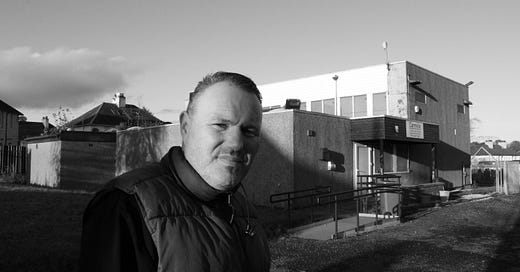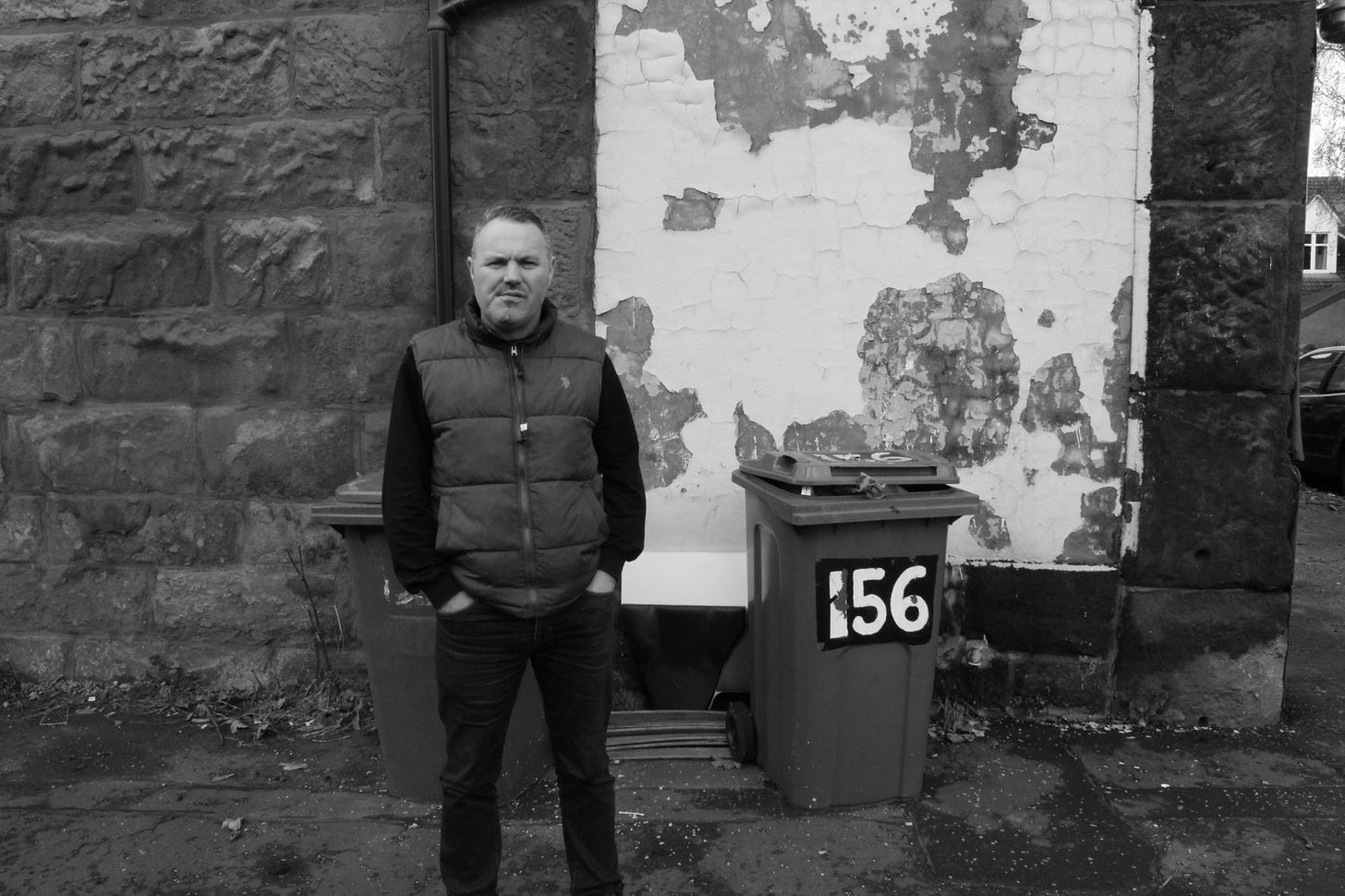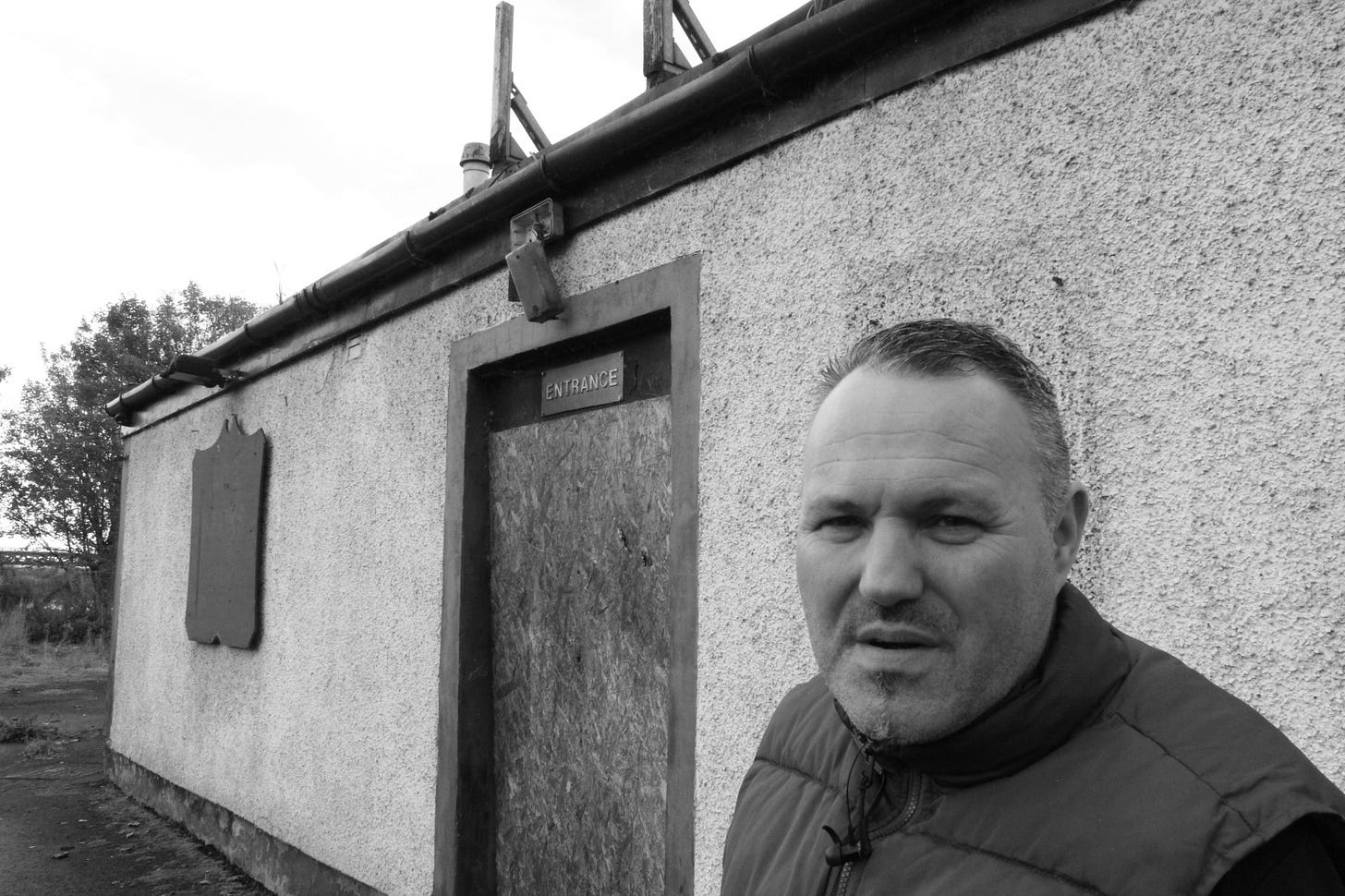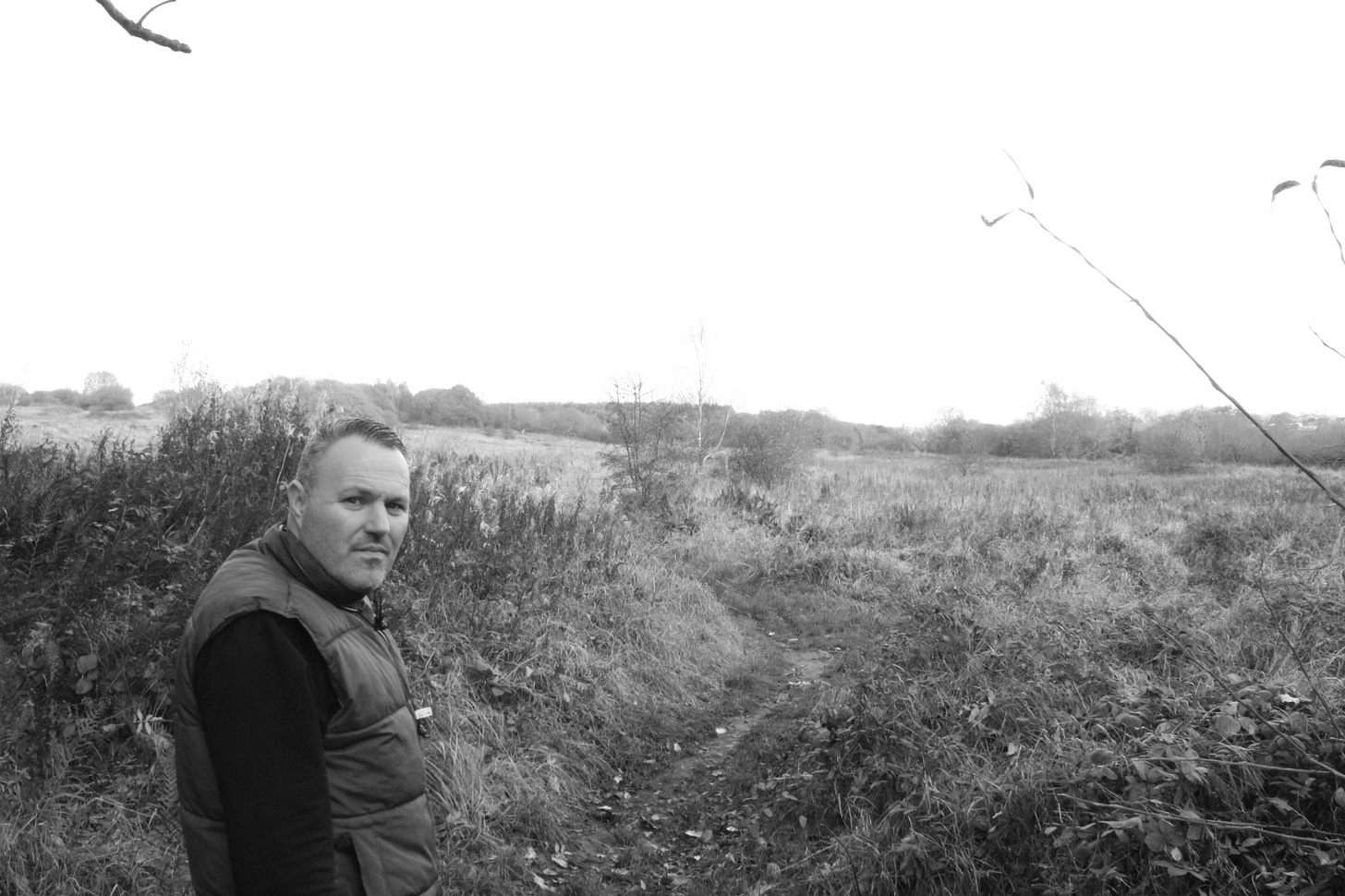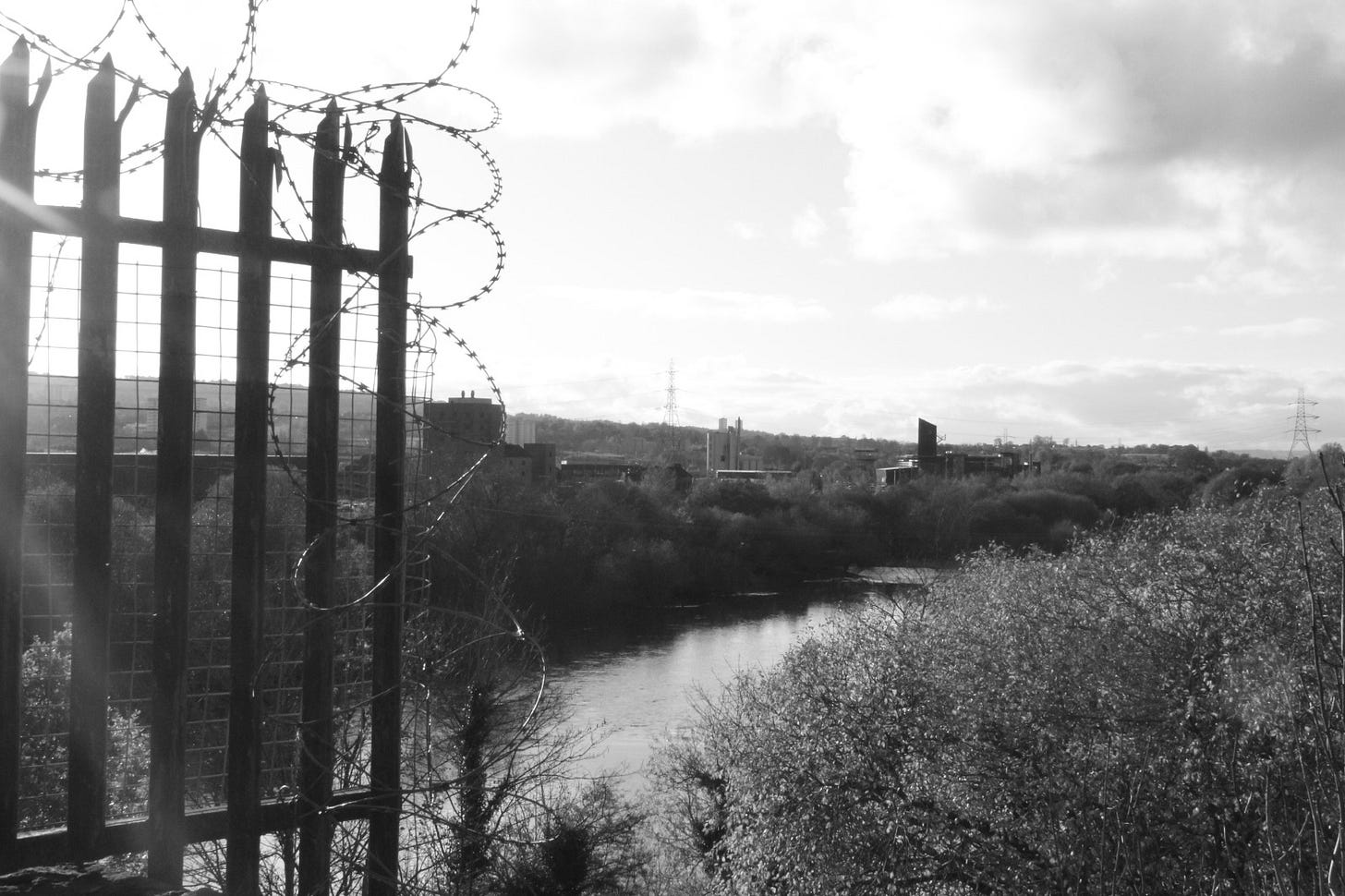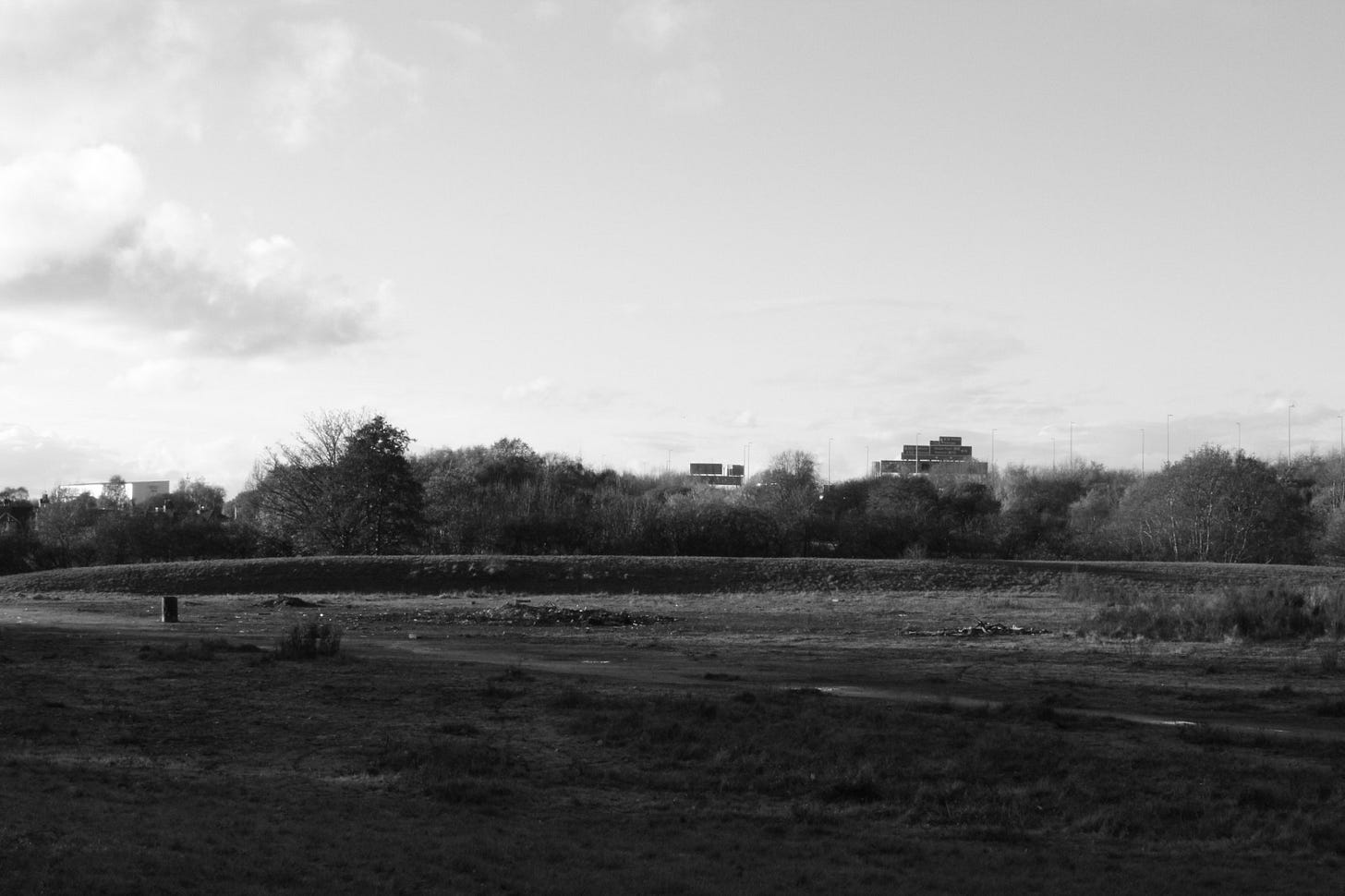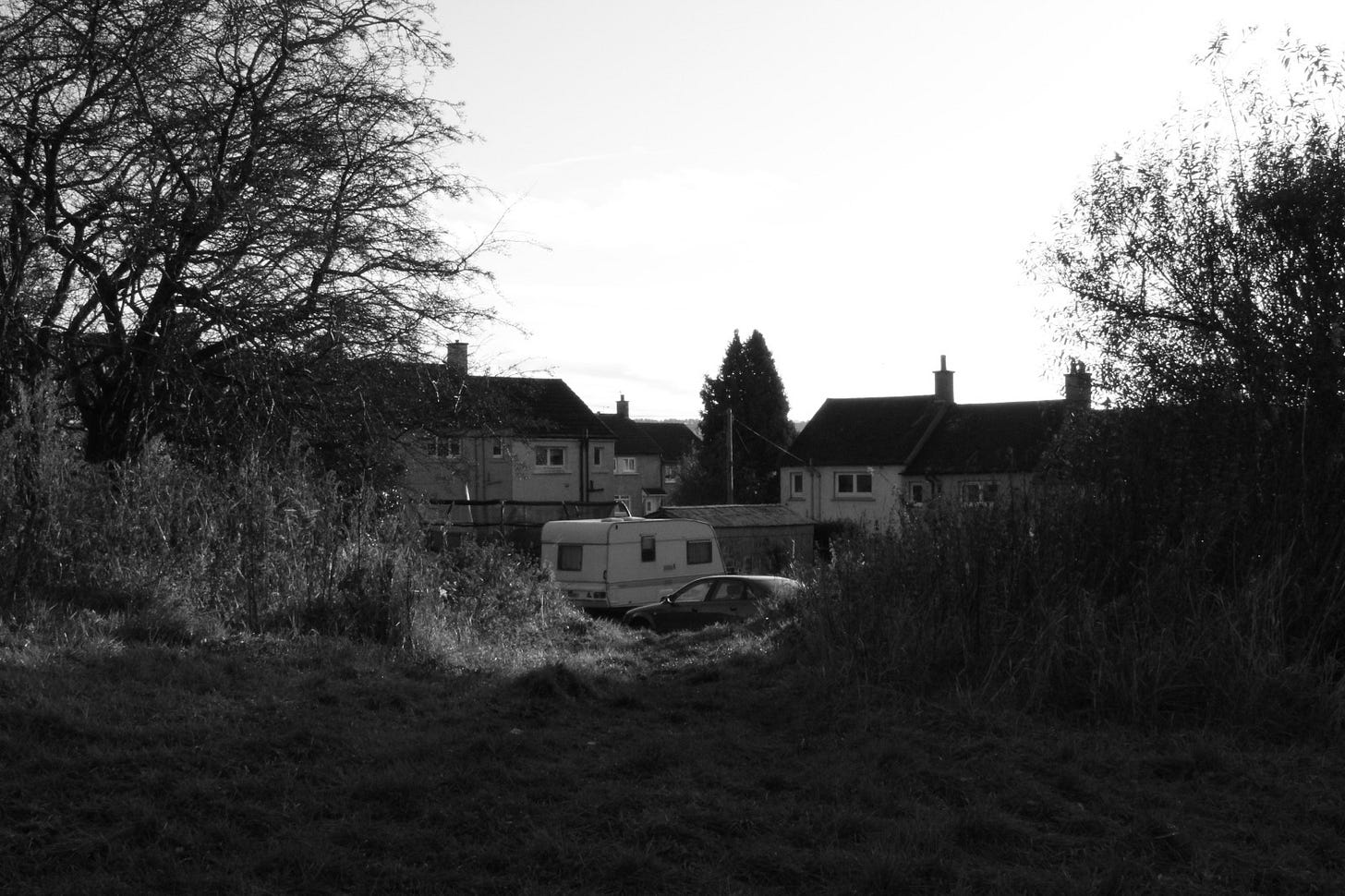‘Glasgow’s forgotten village’ is how Chris described Carmyle when he first suggested a walk round his home land. Sandwiched between the M74 and the River Clyde, with an industrial estate preventing any escape, it’s not hard to imagine why he described it in such a way, but I was intrigued as to why he said village rather than town or scheme.
I park up at a small crossroads in the centre of the village, in front of me on the left is an old Church building, the brown stone building is set just off the main road, large ornate windows peer over the small wall that separates the church grounds from the main road. Buttressed onto the side is what looks like a tower from a mediaeval castle, the roof trimmed with mock ramparts and a small wooden dome proudly hoisting an ageing weather cock.
Directly in front of me a large hedgerow obscures my view of the unique attic window terrace housing that runs parallel to the row of old Glasgow style tenements on either side of where I'm parked. Head up the main artery to my left, I buy some sustenance from the newsagents turned post office bursting at the seams with everything from stationery and toys to iced coffees and domestic necessities. Looking through the window of the next unit along, barber’s chairs collect dust in the dying winter light.
Chris appears suddenly behind me, hair cropped close to disguise any greys, he’s wearing a green body warmer over a black jumper and jeans, the look finished with a pair of running trainers. Trade Union convener for the city’s refuse collectors, he’s known affectionately by many Binmen as Taz, named after the 90’s cartoon character. He’s always reminded me more of the energiser bunny, due to his relentless campaigning and an incredible knack for outrunning his opponents, forcing them to give up long before he’s even broken a sweat.
Pulsing with trademark energy, Chris leads me down the main street, passing an empty shop front bearing the ghost sign of a long closed bookmakers. A few doors down sits a modern barbers, a chinese takeaway and a newsagents. Chris points down the hill towards a sheltered housing complex and a block of freshly built red brick flats. The flats, Chris tells me, stand on what was once the site of a pub owned by former Motherwell and Celtic striker ‘Dixie’ Deans.
In front of us stands the site of a derelict pub at the base of the hill, its empty shell acts as an accidental flood barrier defending the village from the River Clyde. To the right is a walkway and cycle path that will take you from east to west through the city, and eventually out to Loch Lomond. The last pub in the village that still opens its doors sits on this path, 100m further down the road and you can enjoy the delights of the local bowling club.
Chris explains that this small back road is to be widened to allow construction traffic in and out the village. The bowling club and pub will have to give way to lorries, tractors and diggers, shovelling mountains of earth and gravel from the other side of the tracks. The tracks in question lie a few hundreds metres further up river. A rusting and fenced off bridge is the most visible remnant of an old colliery line that once linked Carmyle with Westburn on the opposite river bank.
Leaving the abandoned behind us, we walk up river towards the railway bridge. A diminutive and softly spoken man with a greying moustache, stops to talk to Chris, he tells us that he took up walking during lockdown and now circuits the village and beyond twice a day. As we explore how drinking habits have changed, he offers an explanation that people may find it intimidating to walk into a pub where everyone turns around to see who's coming in, but that is purely due to the close knit nature of the village where everyone knows each other, rather than an intimidation tactic.
We bid our fellow trekker farewell and began our walk along the river, a small muddy footpath leading us in the direction of the disused railway bridge. Here the river flow is disturbed by a large v shaped dam, in the middle a large island of trees and bush provide paradise for visiting birds and wildlife. On the opposite bank a large warehouse and a metal tower showing signs of fire damage look like more abandoned industry, but turns out simply to be the fire brigade training centre.
Reaching the stone foundations of the bridge Chris explains that the tall silver floodlights installed were the product of some ‘forward thinking’ councillors that received funding to improve the area around the river. Passing under the bridge the path leads out onto a huge expanse of greenery. The field gently slopes up towards a crown of trees about a mile in the distance, to its right the river bends behind the crest of the hill, providing a clear view of the massive new built estates in Newton.
Those distant estates Chris explains, have swing parks, benches, huge driveways and houses with bedrooms enough for ample home office space. He’s heard it said that loads of managers in the council have moved out to the new estate just beyond the city’s boundaries. I wonder if it is the success of such estates that have led to the scramble over the land we now stand on.
We can see evidence of how the local community has begun to reclaim the area, well trodden dog walking trails have been worn in the land in every direction. I ask if the money that was spent on lighting the bridge could have been better used to improve the myriad of trails that surround us.
Walking back on ourselves we climb the steep embankment for a better view, on the northern edge of the field lies the M74, venture beyond the motorway and you find yourself in Pattersons Quarry and the adjacent landfill site. Focus your eyes directly East, you can see Daldowie Crematorium, south over the river, the villages and estates of Newton, Drumsagard and Westburn, in the distance the residential tower blocks in East Kilbride can be seen peering over the peak of Dechmont Hill.
A 8ft metal fence prevents us from crossing the bridge, those who are more agile may be able to squeeze through a gap forced in the railing and risk a balancing act to reach the other side. Gazing through the barbed wire prevents further attempts from either side, looking west into the city, the foothills of the Western Highlands faintly visible in the distance, here it has the feel of an American rust belt mining town, stare long enough and your mind might trick you into hearing Bruce Springsteen crooning voice regale you with a memory of lost love.
Chris leads me North along the old tracks, trees have grown up around us creating a leafy tunnel. The old village on our left, greenbelt land on our right, Chris is worried that should housing be built on the greenbelt as proposed, this railway line and embankment will create a physical barrier from the old village and the new estates. Similar to how the river formed a barrier between the people of Carmyle and Westburn, with the bridge the only crossing becoming the frontline in running battles that lasted decades. The graffiti and broken glass that line the path are fading scars from the generational wars of the past.
Turning off the rail line back towards the outskirts of Carmyle, we venture out into another open green space where an old red blaze pitch grassed over is sodden and muddy. A little further on a path that leads us closer to the motorway, a massive sign directing drivers to Greenock rises from the trees, cold and dominating, below it, grass embankments create an eco-friendly amphitheatre, in the middle evidence of a recent bonfire lies dormant and dusty.
Through an access road that also serves to be what may be the smallest primary school in Glasgow and we are back on solid tarmac. I stopped to take a picture of the same Motorway gantry as before, now close enough for it to look like an odd loft conversion for the house at the end of a tight residential street. Reaching the end of the street, a voice calls out from a parked car asking what I'm taking pictures of. After a brief explanation I'm free to go on my way as long as I'm not the social. Barely a few feet round the corner and another voice calls on Chris asking what is happening with this year's pay rise for council workers.
Avoiding the school rush Chris guides me to the local community centre, it’s still publicly owned through one of the Council’s many paper companies but run locally by a committee of local volunteers. As a committee member Chris is jointly responsible for trying to secure funding for running costs and any projects they want to run, a task that is becoming harder for many similar communities across Scotland.
The school rush over we venture back out onto the road, when we are stopped by another council worker asking if Chris can help explain how much back pay they should receive after this year's pay negotiations. Whilst we speak, I spot an increasingly threatened species, an ice cream van. I make my best attempt to be inconspicuous and photograph the beautifully detailed van as it moves off, only for the driver to come to a screeching halt beside me, again asking why I'm taking pictures. The irate driver immediately placated by the sight and familiarity of Chris laughing at the situation.
Walking back to our meeting point, Chris stops half a dozen more times talking to friends and neighbours. Later on that evening he phones me laughing that we have been spoken about on a Facebook group for the local area. Nothing it seems, gets past the good people of Carmyle.
The character and community spirit of Carmyle is undeniable. What impact future planned developments (that will tear up huge parts of the village) will have and how much it will change its inherent village feel, remains to be seen. It was comforting and even nostalgic to walk round the forgotten village, however the winds of change are whistling through the short streets tucked away in Glasgow’s East End.
Policy decisions such as green belt planning, an economy that relies on restricting and exploiting the housing market, a low wage economy and cuts to public services are all playing out in this tight knit community. A general election is round the corner, the warning signs are flashing but will the political circus take the time to turn off the beaten track and spend some time in the nooks and crannies that make places like Carmyle so special.

